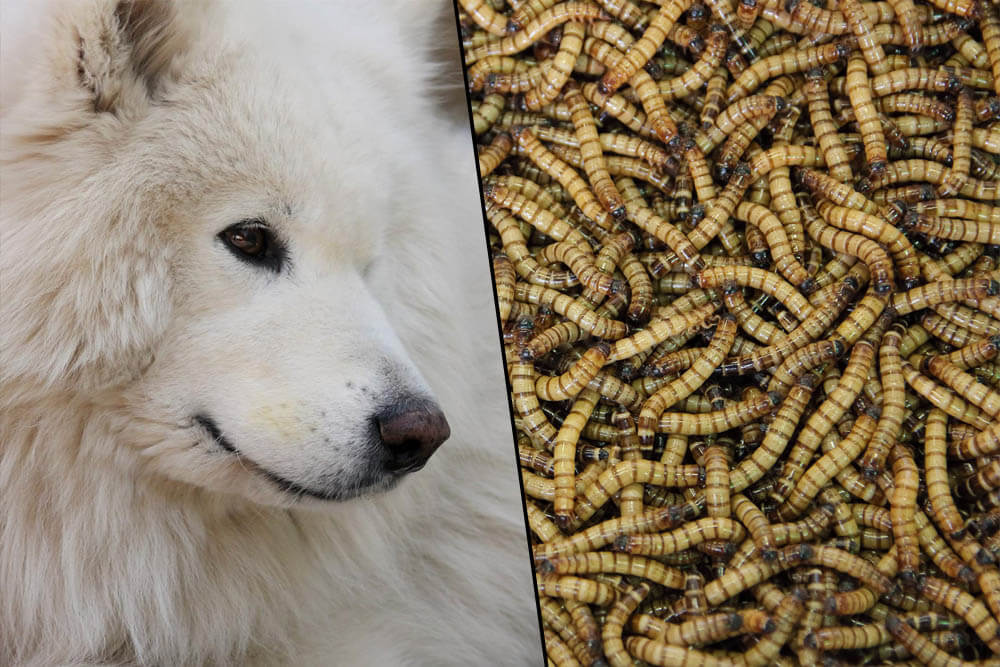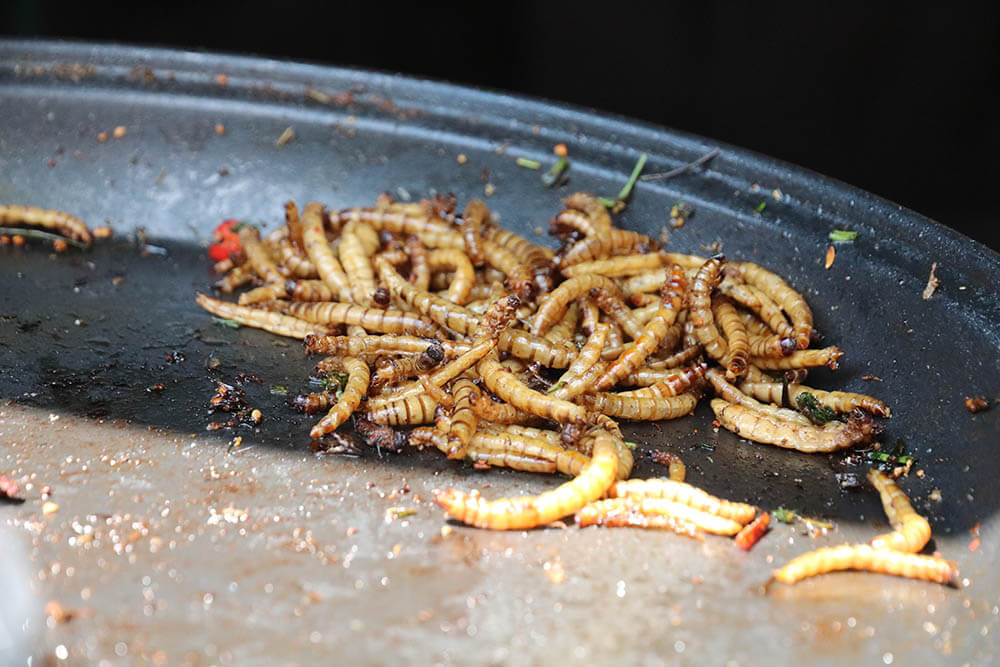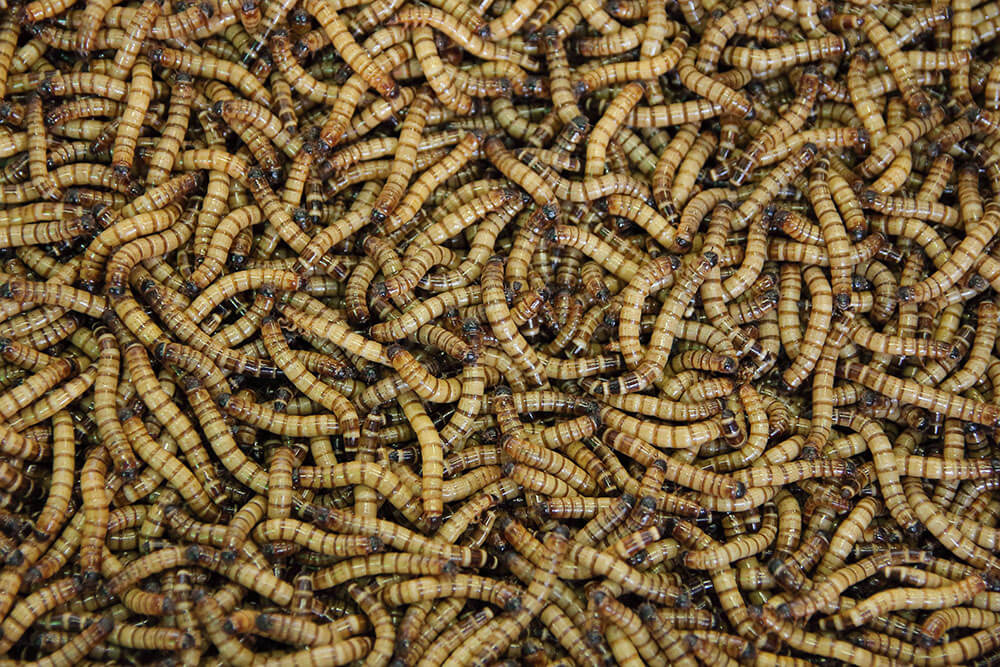Who knew those disgusting, creepy crawlies known as mealworms could be packed with so many nutrients?
Yes, the mealworm—the mealworm beetle’s larval form—is extremely nutritious. Even better news for dog owners: mealworms are good for dogs.
Let’s dive into what makes mealworms such good snacks for canines!

Are Mealworms Good for Dogs?
Yes, both live and dry mealworms are good for dogs.
Protein
Mealworms are ridiculously rich in protein. Live mealworms are 20% protein, while dried mealworms are a whopping 53% protein.
But what’s so good about protein?
For starters, it’s essential for the formation and maintenance of tendons, cartilage, and ligaments. It also helps with blood, skin, muscle, nail, and hair formation.
In addition, protein is broken down to generate amino acids, which sustain a dog’s life and grants them the energy they require to move around. Mealworms are especially beneficial to dog breeds that enjoy a physically active lifestyle, such as sports dogs and working dogs.
Without sufficient protein in their diet, a dog’s organs, cells, and immune system will suffer. In the worst of cases, they could suffer from depression, lameness, liver disease, neurological issues, and a leaky gut. Other problems include reduced milk production, poor skin and coat, weight loss, anemia, and changes in mood.
Fiber
Mealworms are high in fiber, and fiber benefits dogs in multiple ways.
Firstly, fiber aids in digestion and keeps the digestive tract healthy. The canine intestine is home to good bacteria that ferments fiber into fatty acids, which then help the colon heal from injury and prevent bad bacteria from growing too numerous.
Fiber reduces the symptoms of constipation and diarrhea.
Fiber may also assist in the reduction of colon cancer risk in canines, as it facilitates elimination, which diminishes their exposure to any cancer-causing substances they may have ingested.
This substance also helps dogs manage a healthy weight, which means it can help keep obesity away. Obesity increases the risk of diabetes, heart disease, and heatstroke. It also makes a dog more susceptible to osteoarthritis; the resulting joint pain can then discourage them from exercising, therefore preventing them from enjoying the health and weight loss benefits of physical activity.
Lastly, fiber improves diabetes mellitus. Fiber slows digestion and thus prevents extreme blood sugar level elevations, which, in turn, leads to fewer blood sugar fluctuations. This means fiber may have the capacity to better manage the condition, which explains why diabetic dogs are often put on high-fiber diets.
Potassium
Potassium is a mineral that helps make heart and muscle contractions possible. It triggers nerve impulses, allowing the canine brain to transmit information throughout the body to make movement and many bodily functions possible. It also prevents dehydration by regulating fluid balance.
A lack of potassium can cause lethargy, trouble walking, and anorexia or decreased eating.
Phosphorus
Another important mineral, phosphorus is necessary for many biological processes such as protein and amino acid synthesis, cell growth, energy use, and energy storage. It’s a crucial structural component of teeth, bone, DNA, and RNA.
Deficiencies can lead to bone fractures, poor hair coat, decreased growth, and pica.
Iron
Iron is a mineral that’s heavily involved in the creation of hemoglobin, a protein that red blood cells use to transport oxygen from the lungs to every other part of the body. Oxygen, in turn, converts food into energy, allowing a dog to move around, stay healthy, and survive.
A lack of iron can lead to anemia, lethargy, stunted growth, and a rough coat.
Chloride
Chloride is a mineral that maintains the canine body’s acid-base balance, osmotic pressure, and what goes into and out of its cells.
Deficiencies can result in hair loss, fatigue, weakness, and anorexia or decreased eating.
Choline
This compound is vital for blood clotting and assists with other biological functions. It also decreases the liver’s fat absorption, therefore reducing the risk of fatty liver disease.
Deficiencies can cause the aforementioned fatty liver disease, anorexia or decreased eating, kidney problems, stunted growth, and longer blood clotting times.
Niacin (vitamin B3)
Vitamin B3 a.k.a. niacin plays a crucial role in the maintenance of healthy skin and nerves. In addition, it promotes the proper production of energy and is involved in numerous physiologic and enzymatic reactions in the canine body.
A lack of niacin can result in anorexia or decreased eating, bloody diarrhea, stunted growth, dementia, dermatitis, drooling, damage to the soft tissues of the oral cavity, and in the worst of cases, death.

Is Eating Mealworms Good for the Environment?
The global human population continues to grow exponentially, and raising hundreds of billions of chickens, pigs, and cows to feed us per year is quickly becoming untenable. Simply put, the day will come when the demand for meat will exceed the supply.
Not to mention these animals emit enormous quantities of greenhouse gasses, which, as we all know, contribute to climate change.
One possible solution to this issue is to start eating insects such as mealworms.
Insects are numerous and easy to raise. They’re more efficient at converting what they consume into protein than livestock such as pigs and cows, which means they’re more nutritious pound for pound. In other words, they don’t require as many resources to generate more nutrition.
They also emit smaller amounts of greenhouse gasses than livestock.
In addition, keeping livestock nourished means having them feed on acres of land and thus damaging the environment. If livestock were fed insects, instead, we’d see a drastic reduction in environmental damage.
For all the above reasons, we may be better off feeding dogs—and ourselves—insects such as mealworms.
FAQs About Mealworms as Food for Dogs
It’s time to answer more questions about mealworms as canine snacks!
How many mealworms can a dog eat?
This depends on your dog’s nutritional needs. It’s best to consult with a vet to determine the appropriate number of mealworms your dog can ingest per day.
In general, however, 90% of what your dog consumes should be vet-approved dog food. The remaining 10% should consist of a combination of nutritious, dog-friendly snacks. Therefore, mealworms should be part of this 10%.
Can mealworms make dogs sick?
Mealworms are safe for dogs to eat. These insects aren’t toxic to them at all. Besides, dogs consume insects all the time—most of them less tasty than mealworms.
However, ingesting an enormous number of mealworms may give a dog digestive issues. This is thanks to the hard, outer layer of their bodies known as chitin, which can be tough to digest.
Also, make sure to read the ingredient labels of commercially available mealworms, as some manufacturers add substances that may not be good for dogs. The mealworms should be as plain as possible, meaning no salt, sugar, herbs, or other substances that can make a dog ill.
Are mealworms the same as earthworms?
Mealworms are different from earthworms. Mealworms aren’t worms but the larvae of the mealworm beetle. They have small, brown-orange bodies that are harder than worms’. They also have six short legs.
In contrast, earthworms are worms with pink, fleshy bodies that are softer and larger than mealworms’. They have no legs.
Dogs can’t eat earthworms, as these creatures consume dirt that can be populated by harmful parasites and bacteria.
Can a mealworm bite a dog?
Yes, mealworms have mandibles that they use for holding, cutting, and eating food. However, it’s rare for mealworms to bite as they are gentle creatures. The bites are also not dangerous, though they may cause discomfort to or even hurt your dog.
If you’re worried about a mealworm biting your dog, it’s best if you feed them dried mealworms.
Should I give my dog live or dried mealworms?
Dried mealworms are better for dogs as they’re higher in protein, fiber, and other nutrients. Being dead, they also can’t bite your pooch.
Are dogs allergic to mealworms?
Some of them are. Check with your vet before feeding your dog mealworms to ensure they’re not ingesting something they’re allergic to.
Can dogs eat mealworms caught in the wild?
In general, it’s not a good idea to feed your pooch anything caught in the wild. So while feeding a dog a wild-caught mealworm is unlikely to make them sick, we don’t recommend taking the risk. Buy mealworms from a pet shop, instead!
Can puppies eat mealworms?
No. Puppies have extremely sensitive stomachs, which make them prone to experiencing digestive issues such as vomiting, gas, diarrhea, bloating, and abdominal pain. Not to mention they have different nutritional requirements than adult dogs.
Wait until your puppy is at least a year old before giving them mealworms.
Can dogs eat superworms?
Superworms are like mealworms but bigger, so yes, dogs can also eat these larvae.

Conclusion
Yes, dogs can eat mealworms. Even better, mealworms are a great source of protein, fiber, and a host of other nutrients that all canines need to stay healthy, strong, and happy.
So give your pooch a taste of the gross and creepy—feed them some mealworms!
